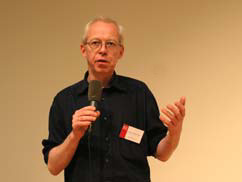The difference between the NTT Intercommunication Center's 2000 show,
Sound Art--Sound as Media, and its current Sounding Space: 9 Sound
Installations, is that the previous show considered sound as an element
of media technology, whereas its follow-up takes the idea and
perception of sound to a completely different level.
This time, sound isn't necessarily used to illustrate an idea, it's the
idea in itself. The works on display are meditations on the
relationship
between sound and the spaces that contain them, or the use of sound or
space
to accommodate the creation of the other. Roughly divided into two
groups,
they deal with how sound can change our understanding of our existing
environment,
as well as how our presence can alter the shape of a sound.
At the core of Sounding Spaces is the question of how the listener
actually deals with sound, which is explored particularly well in works
like David Cunningham's The Listening Room. Unabashedly low-tech, the
room captures and
processes sound using only a pair of mikes, amps, speakers and a noise
gate,
which prevents unwanted noise from getting from the mic to the speaker.
Focusing
on the natural resonances and reverberations of the room, it hums with
a
life you'd never really notice of a room absent of objects that
"create" sound.
"Our hearing is a very precise tool yet we constantly render it
ineffective," writes producer-artist Cunningham in an e-mail from his
studio in London. "Over the last century, background noise in cities
has risen exponentially...I'm trying to find a way to engage positively
with this, to make it a more rewarding experience through being more
conscious of what we are hearing all the time."
Cunningham first set up The Listening Room in London in 1994, and since
then, the installation has been transplanted to all manner of spaces,
from
dark basement spaces to sprawling rooms nestled in the middle of nature
reserves. Adapting the installation for the Tokyo show marks a handful
of firsts: For one, The Listening Room has never occupied a space with
windows until now. Cunningham makes the most of this by keeping the
blinds open and using the glass to reflect the room's acoustics. At
first, the view of bustling Shinjuku is a bit distracting, but with
time, it begins to make more sense, that The Listening Room is a living
document, a complex antithesis of isolation from the rest of the world.
At the same time, the ICC space is the piece's smallest home to date.
Size being one of the many factors that affect the installation,
Cunningham says the Tokyo piece is perhaps the most quiet and subtle of
all the rooms, as space size determines the volume of the installation.
As a result, the sound in the Tokyo room becomes a reflection of the
movement inside it. In a way, the scale of the work draws attention to
what we're listening to--we're not hearing something, we're
experiencing what is occupying the space.
"There's an aspect to all this which is to do with transparency,
demystifying the process and the fact that there's all this activity
across the city visible but mostly inaudible from this particular
situation reinforces this emphasis on the moment within the space,"
Cunningham explains, admitting that he had no idea of the view outside
the window ahead of the show's opening.
Other pieces like sound pioneer Alvin Lucier's Empty Vessels (Tokyo)
also consider how movement alters sound, which he does by setting up a
line of miked glass jars and vases which pick up vibrations that are
fed back from their own speakers situated at the opposite end of a
long, dark room. In effect,
Lucier has created a musical instrument that takes up an entire room
and
plays continuous music that is constantly being manipulated by the
presence and movement of the people in the room. Like The Listening
Room, Empty Vessels (Tokyo)'s tones are distinct, and are susceptible
to pauses and crescendos, which change as each of the vessels' feedback
strands are disrupted by visitors moving about the room.
At the top of the stairs that lead to the viewing rooms, there's a
constant hum of blips, crackles and beeps that are released from two
monolithic, interfacing screens textured with specks, bars and lines of
color. The way they've been placed creates a small corridor between
them, above which hang two microphones and two speakers. This is
Akihiro Kubota's Material AV--Resonant Interface, which uses existing
sound as a raw material and processes their pitches and harmonic
components, creating a feedback that is looped back into the system.
The numeric data from these sounds are processed into images, which
change according to different sounds that are introduced into the
system, offering an exciting, visual element.
Works like Christina Kubisch's East of Oasis--Twelve Gates to Sound and
Edwin Van Der Heide's A World Beyond the Loudspeaker use sound to alter
our
perception of space. Kubisch has set up a maze of hanging cables that
transmit
different sounds from the jungle that are picked up on a headset,
creating
a sense of wonder and excitement as you approach each cable in the
open,
white space. And new meaning is given to the idea of surround sound in
Edwin
van der Heide's A World Beyond the Loudspeaker, a wall of 40 speakers
that
play sounds from industrial sites picked up by 40 microphones. Housed
in
a small room, the sound of construction sites and harbors fill the room
with
an overwhelming three-dimensionality that challenges the room's
spatiality.
Copyright 2003 The Yomiuri Shimbun
Installation Notebook
return to:
Installations
Activated Space
